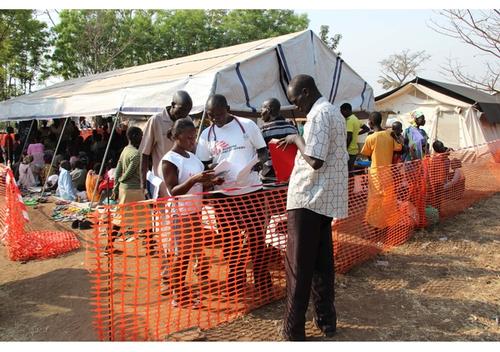Some 700 refugees, mostly women and children, are crossing from South Sudan into northern Uganda each day to escape violence and insecurity. Since the conflict started in mid-December, more than 45,000 South Sudanese have arrived. Many come from the city of Bor, in Jonglei state, which has seen episodes of heavy fighting in recent weeks. The new arrivals in northern Uganda are settling in overcrowded refugee camps near the border.
Heat and dust. Welcome to Dzaipi, in northern Uganda, 7 km from the South Sudanese border. The hundreds of people arriving each day have had long journeys to reach here. Most walked for four or five days from the South Sudanese city of Bor to the capital, Juba, then took a truck for several hours to reach the border crossing of Elegu, where they were registered as refugees and brought to Dzaipi, a small transit camp set up in Adjumani district to house the refugees temporarily. Already, the refugees have outgrown the space in the camp.
“Dzaipi transit camp was designed to accommodate 3,000 people, not 30,000,” says Ruben Pottier, MSF’s head of mission in Uganda. “With 2,500 people arriving each day during the first three weeks, it was immediately overcrowded. People had to shelter under trees, or at best inside the building of the local school, without access to basics such as water, food, latrines or healthcare.”
Most of those crossing the border at Elegu are Dinkas, one of the main ethnic groups in South Sudan. Refugees from the Nuer ethnic group are mostly crossing into Uganda at Kaya, in neighbouring Arua district, and are settling in Ocea transit camp, where 10,000 refugees have already been registered.
'Few men are here'
Most of the refugees are women and children. “It really strikes you, when you walk through the camp, how few men there are here,” says Pottier. While some families managed to bring some belongings and a little money with them, others have nothing.
“People bring their ethnic divisions with them,” says Pottier. “We do see tensions between the two communities, especially around the water tanks. In Dzaipi transit camp, most refugees are Dinkas. The Dinka majority stopped the Nuers from fetching water from the tank, so we had to set up another water tank in the Nuer area of the camp.”
In an attempt to lessen the overcrowding in Dzaipi camp, and to clear the school building before classes start again at the end of this month, new arrivals are being taken to nearby Numanzi camp, one of a number of locations identified to host the refugees.
“Since Numanzi camp opened, new arrivals coming from Elegu are taken there directly, by truck, and spend two to three days in communal shelters before being given a plot of land on which to set up their tent,” says Pottier.
Camps will soon be full
Numanzi camp has space for 20,000 people, but with an average of 700 new arrivals each day, it is likely to be full by the end of next week. There are concerns about how many more refugees the region can cope with, particularly given the tensions between the ethnic groups.
“With the ongoing influx of refugees, when one camp gets full, another is opened,” says Pottier. “But the local capacity to absorb such a large influx of refugees is a real concern, all the more so considering the ethnic tensions that exist.”
The humanitarian response to the refugee influx in northern Uganda has been slow, and has so far involved just a few aid organisations. MSF has been providing the refugees with clean drinking water and with medical care.
“MSF has covered 90 percent of the clean water provision in Ocea, Dzaipi and Numanzi camps so far,” says Pottier. In Ocea and Numanzi camps, MSF is running outpatient clinics set up in tents. As well as providing consultations, MSF’s teams are screening children under the age of five for malnutrition and vaccinating new arrivals against measles and polio.
Outbreaks of infectious diseases
“So far the global malnutrition rate is under five percent, which means that people are arriving in a relatively good nutritional condition,” says Pottier. “But we need to be very vigilant. This area is subject to frequent outbreaks of infectious diseases such as cholera and meningitis, and two suspected cases of measles have already been detected in Dzaipi.”
Severe patients in Ocea and Numanzi camps are referred to Dzaipi, where MSF has set up a small inpatient ward and maternity unit.
“Most of the families in the camps have relatives who are still in South Sudan,” says Pottier, “and so there is a fair amount of anxiety among the refugees.” says Pottier. “But South Sudanese people have grown up with conflict, and their life doesn’t stop because of it. In the camps, you can see small business starting up, and there are vegetables in the markets. Step by step, people are moving on. Life has to continue.”



